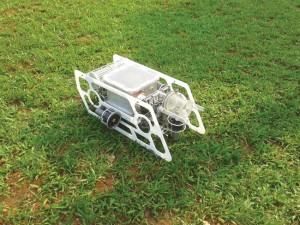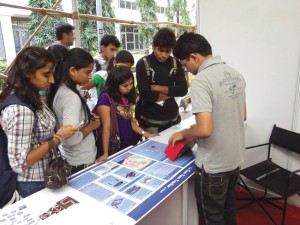INNOVATION HAS ALWAYS BEEN AT THE HEART OF THE IIT CULTURE. HERE’S A SNEAK-PEEK INTO WHAT ITS STUDENTS HAVE BEEN UP TO
 MATSYA
MATSYA
It can localise itself in the deep seas and perform tasks required for naval purposes.
What: Matsya, meaning fish in Sanskrit is an underwater vehicle developed by the students at IIT-B.
Uses: It can be used for marine research, as well as navigation and rescue operations.
Current Stage: The project is supported by IIT-B as well as several corporate sponsors. The team is working on the second version, Matsya 2.0. This version is expected to be more suited to commercial needs and will also have more features.
Awards: In the International Autonomous Underwater Robotics Competition, Robosub, held annually in San Diego, in July 2012, Matsya qualified for the semifinals and was ranked 10th out of 32 global entries.
Team: Sneh Vaswani, Chintan Raikar, Prashant Iyengar, Anay Joshi, Shivendra Singh, Amit Kumar, Mihir Gupta, Savant Krishna, Satwik Kottur, Akash Verma, MV Deepak, Nilesh Kulkarni, Rakesh Kumar, Dinesh Kumar, Hardik Godara, Sant Kumar, Suryapratap Babar, Tushar Sharma, Devyesh Tondon, Sanidhya Gupta, Anshuman Kumar, Kunal Tyagi.
What its Developers are Saying: “Matsya is a low weight single man portable system that is designed for shallow water conditions. The subsequent version of the vehicle has also been equipped with pneumatic actuators to identify and grip objects of interest. It has enormous applications in surveillance, reconnaissance, fisheries etc.” – Team leader Sneh Vaswani
 PARINAT
PARINAT
It mimics a person in real time and replicates his/her movements.
What: A concept reminiscent of the movies Real Steel and Transformers, Parinat (Sanskrit for transform) is IITB’s first transforming humanoid.
Uses: As a transforming humanoid, it can have several applications, ranging from carrying out rescue operations to exploration and research work in harsh climatic conditions.
Current Stage: Under development. A dedicated team of 10 students is working on a 14 degree of freedom model that it will have greater flexibility in its movements. This can transform between a humanoid mode and a vehicle, similar to the ones in the film Transformers.
Team: Ashay Tejwani, Alap Kshirsagar, Sundaram Prasad, Urvesh Patil, Krishnakant Saboo, Goutam Bhat, Nimit Kumar Singh, Vishweshwar Singh, Aman Berlia and Aayush Yadav
What its Developers are Saying: “We started off with a simple biped (two-legged robot) and are currently assembling a 14 degree of freedom transforming model (our fifth prototype).”
 TUM TUM TRACKER
TUM TUM TRACKER
A bus tracking system developed for the buses of IIT Bombay.
What: TUM-TUM Tracker, named after the popular bus service in IIT Bombay, is a bus tracking system which can be implemented by creating a mesh network all over the campus using the modules present in buses and at bus stops. Unlike the GPRS one (which needs data connection from a cellular network), it requires only a one-time investment in the form of a wireless device (X-BEE Pro).
Current Stage: The prototype of this model is ready to be implemented. However, gaps in funding as well as a cap on student projects are hindering its mass implementation. The developers are trying to fund the infrastructure through other means.
Uses: With its novel design and application, it has the potential in making bus travel a lot more convenient.
Team: Sudheer, Jithendar, Varun, Sumanth, Sushanth
What its Developers are Saying: “We provide display interfaces at bus stops displaying the time and route of the approaching buses and also have web and Android application which displays the position on Google maps for users. The major challenges in our project are implementation of mesh network and long range communication without any recursive cost.”
 ZUMBL.COM
ZUMBL.COM
Zumbl, invented by the students of IIT Delhi, is an online platform to chat and interact with strangers.
What: Meeting random people online and chatting with them has been around for quite some time. Zumble.com takes the process a step further by refining the user experience. It takes the user’s basic information as well as likes and dislikes into account, which allows the user to chat with people having similar interests. It can be downloaded both on the phone and the computer.
Current Stage: The site is live now. Users can create a profile through their Google or Facebook accounts.
Uses: A brilliant way to change the user experience of online conversations, Zumbl is a fun application that will appeal to many.
Awards: Finalist in Samsung Innovation Awards 2012
Team: Abhishek Gupta, Devashish Tyagi, Saurabh Kumar, Sherjil Ozair
What its Developers are Saying: “Zumbl basically makes your chats with strangers more meaningful and fun by giving you features like having a profile without your real name and tags (what people think of you as). The tags that you earn will shape your online identity that is your Avatar and show you how you look through a stranger’s eyes! Zumbl is here for you whenever you feel like talking to someone! ”
– Saurabh Kumar
 HAND-PIC’D
HAND-PIC’D
A versatile and easy-to-use controller that can function as the digital extension of our hand.
What: It is a generic gesture-based controller that can track the tilts and position of whatever object/body part it is attached to and can be used to control another gadget based on the movements of the object it is tracking.
Current Stage: The concept involved in Hand-PIC’d is still under development, similar to Parinat, which uses it to make the bot mimic the user.
Uses: It has a wide range of applications and can serve as a computer mouse, a robotic arm among others. It understands the motion of the user, instead of the user learning how to operate it.
Awards: Finalist in Samsung Innovation Awards 2012
Team: Ashay Tejwani
What its Developers are Saying: “The prime advantage HandPIC’d has over most devices currently available as controllers is the fact that it doesn’t have any
buttons or joysticks which need to be learnt and adapted to, nor is it dependent on ambient lighting conditions or limited to a certain 3-D space for its use. That was the prime driving force behind its development.”
– Ashay Tejwani
 SELF-BALANCING SKATEBOARD
SELF-BALANCING SKATEBOARD
A skateboard capable of carrying a person which functions mostly like a segway. What: As the name suggests, this is a self-balancing vehicle that uses sensors to balance it while the turning can be done manually or by integrating it with pressure sensors.
Uses: An easier alternative to the current skateboard, this can help those who shy away from skateboarding.
Team: Kalpesh Patil, Prateek Shah, Akash Patil
What its Developers are Saying: “Our main motivation for this project was the self balancing bot (a small scale model) we made during our first year. The control of the skateboard is based on the simple idea of how we balance things: Give a torque opposite to its angle with the vertical. This is achieved by calculating the angle using sensors (accelerometer and gyroscope) and applying the corresponding torque with motors.”
 INTERNATIONAL STUDENT INVENTIONS
INTERNATIONAL STUDENT INVENTIONS
Socket
A football that captures the energy created when it is kicked. It generates enough energy from 30 minutes of play to power a light for three hours.
Team: Four Harvard engineering students – Jessica Lin, Julia Silverman, Jessica Matthews, Hemali Thakkaras.
Air Guitar
A versatile guitar app that actually allows you to physically strum on your iPod and iPhone, using the in-built accelerometer present in the device.
Team: James Anthony and Edward Marks from Stanford University
Cityslips
Foldable ballet flats that can be tucked into a pocket-sized pouch. Portable floats come to the rescue of aching soles that are tired of heel shoes at the end of a long evening.
Team: Susie Levitt and Katie Shea from New York University
Volume 2 Issue 12





























